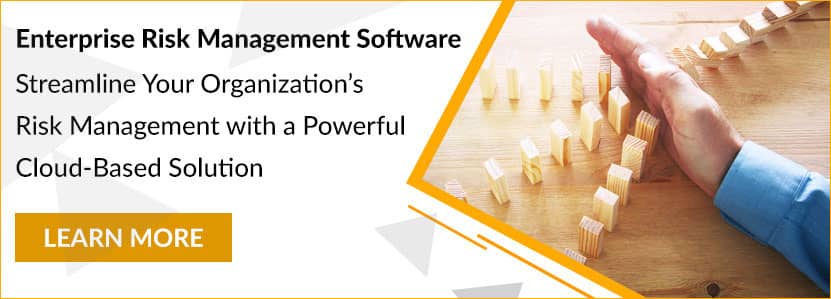Home/ Blog / Enhancing Third Party Risk and Compliance Management
As mid-sized banks and financial institutions grapple with expansion, increased outsourcing, and regulatory operational and financial requirements. It is more critical than ever for the organization to take a strategic approach to risk reduction and management. Vendors and other third parties are becoming an integral part of the banking industry. This has opened a new pandora’s box of risk and compliance issues that need to be managed.

CCOs and CROs are constantly on the lookout for methods to differentiate their businesses. One critical approach is to manage their risk profiles, which assists in identifying the risks and hazards that a business faces. It may include the likelihood, adverse consequences, and an overview of the potential costs and amount of disruption associated with each risk. This requires a better understanding of third-party risks.
Smoother integrations with third parties can be a significant competitive advantage for businesses. Real-time visibility into reliable data enables a business to stay ahead of the curve for vendors. It significantly mitigates the consequences of regulatory compliance negligence, minimizing fines/penalties and reputational damage.
While vendors frequently add value through their solutions, skills, and experience, the bank ultimately bears the responsibility for all elements of its operations, including the products and services offered by vendors. As such, effective risk and compliance management approach is essential to limit the risks associated with a vendor relationship’s loss of control and close oversight.
Common Strategies for Third-Party Risk & Compliance Management
Some of the strategies that are used by businesses include:
Due Diligence
Banks and financial institutions should undertake due diligence before picking a provider. This includes acquiring references, primarily from other financial institutions, evaluating financial documents, and conducting research on the vendor’s principals’ backgrounds, qualifications, and reputations, as well as the vendor’s overall reputation, including litigation filed against it. Additionally, it entails ensuring that the vendor maintains data backup systems, continuity, disaster recovery plans, and adequate IT security and management information systems to ensure compliance.
Smoother integrations with third parties can be a significant competitive advantage for businesses. Real-time visibility into reliable data enables a business to stay ahead of the curve for vendors. Share on XRisk and compliance management platforms provide businesses an easy way to ensure that all vendors have fulfilled all risk and compliance requirements.
Risk Assessments
Based on the initial due diligence evaluation, a detailed risk assessment should be produced. Before initiating a new activity, it should be shared with top management and the board of directors. The risk assessment should cover all potential risks associated with a vendor’s activity, including compliance, reputational, operational, credit, and transaction risks. Additionally, it should identify and comply with all applicable consumer rules and regulations. Modern risk and compliance platforms automate risk assessments, significantly increasing their insightfulness.
Unambiguous Contractual Obligations
Contract conditions should be risk-based, include requirements for compliance with applicable consumer protection laws and regulations, and include a right to request evidence of compliance, such as audit and monitoring reports. Among the critical provisions that a vendor contract should have:
Clearly Defined Parameters
It is necessary to ensure that the expected compliance and service quality requirements are written explicitly in the contract. All the documentation that the vendor will need to provide for compliance purposes also need to be outlined clearly.
Auditing Mechanism
Banks and financial institutions also need to specify the need of audits in the contracts. The vendors should be cooperative with any compliance or risk audits that are required in the financial industry. The vendor should also be contractually obligated to have a mechanism in place to ensure that corrective actions are taken when required.
Comprehensive Surveillance Programs
It is critical to have real-time visibility and monitoring based on the risk assessment generated during due diligence. In addition, vendor performance monitoring should include examining and tracking complaints about the vendor’s operations.
Visibility for Board of Directors
Maintaining an informed board of directors with the vendor management program is critical to ensuring effective oversight of the risks associated with third-party agreements. The board should be able to review vendor management policies, due diligence reports, risk assessments, and monitoring findings in real-time.
Maximizing Value through Risk Management
In most cases, banks and financial institutions’ compliance teams must transition from advisory roles to ones that place a greater emphasis on proactive risk management and monitoring. In practice, this involves going beyond providing guidance on statutory rules, regulations, and laws to taking an active role in risk management and providing an independent review of the control structure.
Risk and compliance departments can generate much value for organizations by streamlining third-party risk management. In addition, ensuring that all parts of an organization’s service delivery chain – first and third party – are operating efficiently can be a significant competitive advantage.
Interested in seeing how your organization can enhance third-party risk and compliance management? Get in touch with our experts for a demonstration of the Predict360 Third-Party Risk Management solution.
Request a Demo
Complete the form below and our business team will be in touch to schedule a product demo.
By clicking ‘SUBMIT’ you agree to our Privacy Policy.




